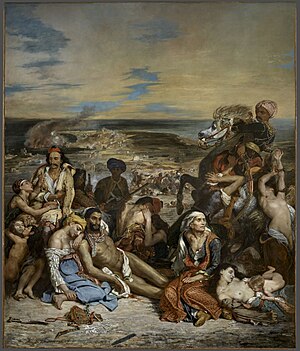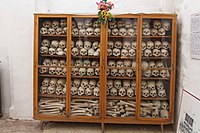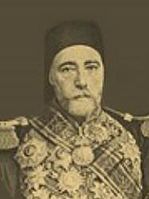Chios massacre
| Chios massacre | |
|---|---|
 The Massacre at Chios (1824) by Eugène Delacroix | |
| Location | Chios, Ottoman Empire |
| Coordinates | 38°21′50″N 26°03′47″E / 38.3640°N 26.0630°ECoordinates: 38°21′50″N 26°03′47″E / 38.3640°N 26.0630°E |
| Date | April 1822 |
| Deaths | 42,000–52,000[1] |
| Perpetrators | Ottoman military |
The Chios massacre (in Greek: Η σφαγή της Χίου, Greek pronunciation: [i sfaˈʝi tis ˈçi.u]) was the killing of tens of thousands of Greeks on the island of Chios by Ottoman troops during the Greek War of Independence in 1822.[2] Greeks from neighboring islands had arrived on Chios and encouraged the Chiotes to join their revolt. In response, Ottoman troops landed on the island and killed thousands. The massacre of Christians provoked international outrage and led to increasing support for the Greek cause worldwide.
Background[]
For over 2,000 years, Chios merchants and shipowners had been prominent in trade and diplomacy throughout the Black Sea, the Aegean, and the Mediterranean. The Ottoman Empire allowed Chios almost complete control over its own affairs as Chioten trade and the very highly valued mastic plant, harvested only on Chios, were of great value to it. The cosmopolitan Chiotes were also very prominent in Constantinople. Following the massacre, however, the island never regained its commercial prominence.
The island's ruling classes were reluctant to join the Greek revolt, fearing the loss of their security and prosperity.[3] Furthermore, they were aware that they were situated far too close to the Turkish heartland in Anatolia to be safe.[3] At some points, Chios is only 6.7 kilometres (4.2 mi) from the Anatolian mainland.
Massacre[]
In March 1822, as the Greek revolt gathered strength on the mainland, several hundred armed Greeks from the neighbouring island of Samos landed in Chios. They attacked the Turks, who retreated to the citadel. Many islanders also decided to join the revolution.[3] However, the vast majority of the population had by all accounts done nothing to provoke the reprisals, and had not joined other Greeks in their revolt against the Ottoman Empire.[4]
Reinforcements in the form of a Turkish fleet under the Kapudan Pasha Nasuhzade Ali Pasha arrived on the island on 22 March.[which calendar?] They quickly pillaged and looted the town. On 12 April [O.S. 31 March], orders were given to burn down the town, and over the next four months, an estimated 40,000 Turkish troops arrived. In addition to setting fires, the troops were ordered to kill all infants under three years old, all males 12 years and older, and all females 40 and older, except those willing to convert to Islam.[5][unreliable source?]
Approximately three-quarters of the population of 120,000 were killed, enslaved or died of disease.[6][7] It is estimated that 2,000 people remained on the island after 21,000 managed to flee, 52,000 were enslaved and 52,000 massacred.[8] Tens of thousands of survivors dispersed throughout Europe and became part of the Chioten Diaspora. Another source says that approximately 20,000[9][10][11] Chiotes were killed or starved to death. Some young Greeks enslaved during the massacre were adopted by wealthy Ottomans and converted to Islam. Some rose to levels of prominence in the Ottoman Empire, such as Georgios Stravelakis (later renamed Mustapha Khaznadar) and Ibrahim Edhem Pasha.[12]
Reaction and Commemoration[]
There was outrage when the events were reported in Europe[13] and French painter Eugène Delacroix created a painting depicting the events that occurred; his painting was named Scenes from the Massacres of Chios. Thomas Barker of Bath painted a fresco of the massacre on the walls of Doric House, Bath, Somerset.[14]
A draft of this painting, created under the supervision of Delacroix in his lab by one of his students, is in display in the Athens War Museum. In 2009, a copy of the painting was displayed in the local Byzantine museum on Chios. It was withdrawn from the museum on November 2009 in a "good faith initiative" for the improvement of Greek-Turkish relations. However, the Greek press protested its removal.[15][16] The copy is now back on display in the museum.
During a session of the Permanent Holy Synod of the Orthodox Church of Greece in Athens on July 14-15, 2021, at the proposal of Metropolitan Markos of Chios, Psara and Oinousses, the Holy Synod glorified Metropolitan Plato of Chios, and 43 others, who were martyred by Ottoman troops in the Chios Massacre on Holy Friday in 1822.[17][18] The list included priests, deacons, hieromonks and monks, to be commemorated on the Sunday of the Paralytic each year.[19]
Gallery[]

Human skeletal remains of the massacre in Nea Moni of Chios
See also[]
- Chios expedition
- Destruction of Psara
- List of massacres in Greece
- Massacres during the Greek Revolution
- Navarino massacre
- Ottoman wars in Europe
- Tripolitsa massacre
References[]
- ^ "Η ιστορία της Χίου, του νησιού της μαστίχας". Archived from the original on 2011-10-02.
- ^ Dadrian, Vahakn N. (1999). Warrant for Genocide: Key Elements of Turko-Armenian Conflict. New Brunswick: Transaction Publishers. p. 153. ISBN 1-56000-389-8.
- ^ Jump up to: a b c St. Clair, William (1972). That Greece Might Still Be Free, The Philhellenes in the War of Independence. London: Oxford University Press. p. 79. ISBN 0-19-215194-0.
- ^ Shupp, Paul F. (1933). "Review: Argenti, Philip P. The Massacre of Chios". Journal of Modern History. 5 (3): 414. doi:10.1086/236057. JSTOR 1875872.
- ^ "Revolution – The massacre of the island of Chios". chioshistory.gr. Archived from the original on 2 October 2011. Retrieved 30 March 2011.
- ^ "Christopher A. Long – The Massacres Of Chios 1822 (2)". christopherlong.co.uk.
- ^ "The Chios Massacre Of 1822". Queens Gazette. Archived from the original on 2018-11-11. Retrieved 2013-03-26.
- ^ "Η Ιστορία της Χίου και τα Μεσαιωνικά Χωριά της". chioshistory.gr. Archived from the original on 2011-10-02.
- ^ Massacre at Chios Archived April 13, 2010, at the Wayback Machine
- ^ Christopher Long (1998–1999): The Massacres of Chios, Events & Massacres of 1822.
- ^ The Open University: Massacres of Chios – Challenging the Establishment[dead link]
- ^ Littell, Eliakim (October 1888). The Living Age. 179. The Living Age Co. p. 614. OCLC 10173561.
- ^ Klose, Fabian (2016). The Emergence of Humanitarian Intervention: Ideas and Practice... Clays. p. 175. ISBN 9781107075511. Retrieved 6 August 2017.
- ^ Cartledge, YJC (Feb 2020). "The Chios Massacre (1822) and early British Christian-humanitarianism". Historical Research. 93 (259): 52-72, at p.60. doi:10.1093/hisres/htz004.
- ^ "Eπισκόπηση Τύπου". naftemporiki.gr. 8 November 2009.
- ^ Chios Complete Guide Archived 2009-08-29 at the Wayback Machine.
- ^ (in Greek) Δελτία Τύπου της Ιεράς Συνόδου: Δεύτερη συνεδρία της Δ.Ι.Σ. για το μήνα Ιούλιο. Διαρκούς Ιεράς Συνόδου της Εκκλησίας της Ελλάδος (ECCLESIA.GR). Αθήνα, 15 Ιουλίου 2021.
- ^ GREEK CHURCH CANONIZES DOZENS OF MARTYRS, ECCLESIASTICAL TEACHERS. Orthodox Christianity. Athens, July 16, 2021. Retrieved: July 17, 2021.
- ^ (in Greek) Αγιοκατάταξη Ιερομάρτυρος Πλάτωνος και των συν αυτώ. ΡΟΜΦΑΙΑ (Ι.Μ. Χίου). 15/07, 15:17. Retrieved: July 17, 2021.
- ^ Simon, Reeva S.; Mattar, Philip; Bulliet, Richard W. (1996). Encyclopedia of the Modern Middle East. Macmillan Reference USA. p. 1018. ISBN 0-02-897062-4.
- ^ Morsy, Magali (1984). North Africa, 1800–1900: A Survey from the Nile Valley to the Atlantic. Longman. p. 185. ISBN 0-582-78377-1.
Further reading[]
- Christopher A. Long – The Series of Events
- The Massacres of Chios Described in Contemporary Diplomatic Reports, edited and with an introduction by Philip P. Argenti (London: John Lane the Bodley Head Ltd., 1932).
External links[]
 The Sisters of Scio. is a poetic response to the massacre by Felicia Hemans, first published in The Literary Souvenir annual for 1830, with an engraving by Henry Rolls of a painting by A. Phalipon.
The Sisters of Scio. is a poetic response to the massacre by Felicia Hemans, first published in The Literary Souvenir annual for 1830, with an engraving by Henry Rolls of a painting by A. Phalipon.
- 1822 in Greece
- 1822 in the Ottoman Empire
- Massacres during the Greek War of Independence
- Amphibious operations
- Battles of the Greek War of Independence
- Conflicts in 1822
- Massacres committed by the Ottoman Empire
- Massacres in Greece
- Massacres in the Ottoman Empire
- Ottoman Chios
- Persecution of Greeks in the Ottoman Empire before the 20th century
- Sieges involving Greece
- Sieges involving the Ottoman Empire



